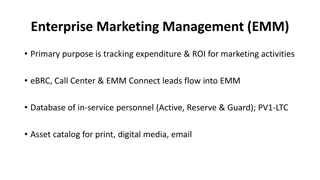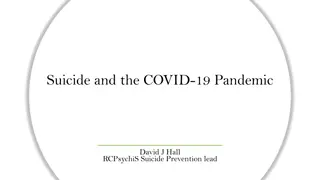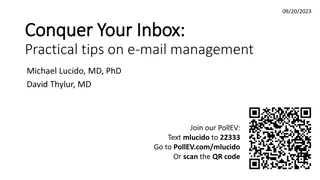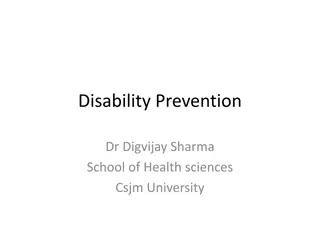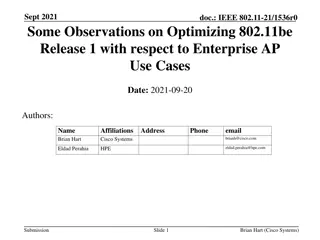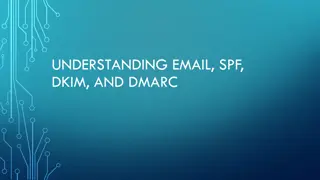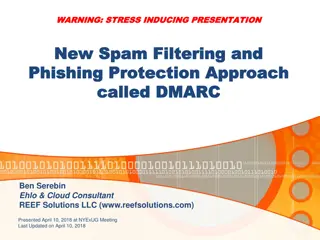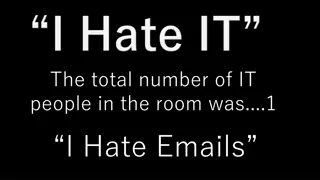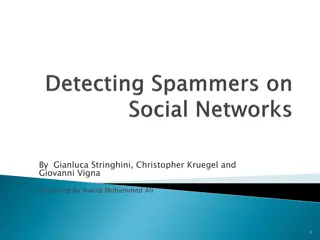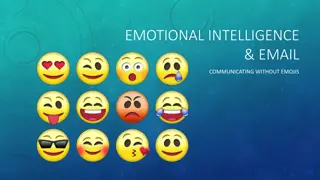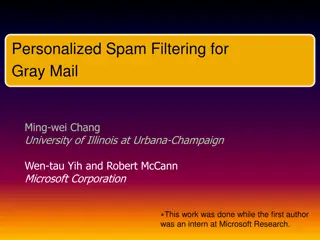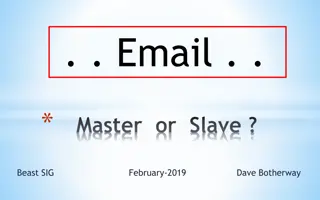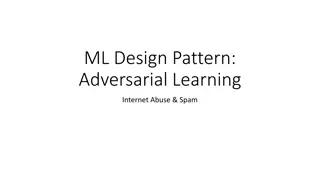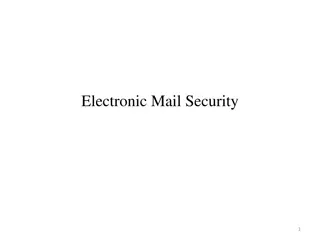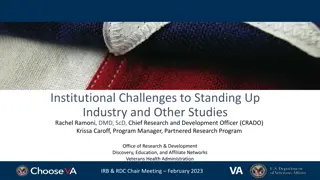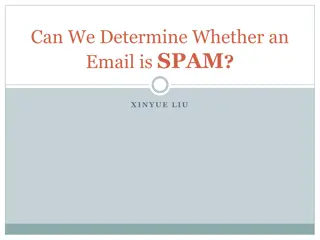Understanding Enterprise Email Spam Prevention Techniques
Learn about the key strategies used by enterprises to combat email spam, including spam filters, SPF records, DMARC, DKIM, whitelisting, and SCL ratings. Discover how these tools work together to protect against spam, spoofing, and phishing attempts.
Download Presentation

Please find below an Image/Link to download the presentation.
The content on the website is provided AS IS for your information and personal use only. It may not be sold, licensed, or shared on other websites without obtaining consent from the author. Download presentation by click this link. If you encounter any issues during the download, it is possible that the publisher has removed the file from their server.
E N D
Presentation Transcript
Enterprise approach to Email SPAM Chain Letters Email Spoofing
Definitions: Definitions: SPAM Filter A spam filter is a program that is used to detect unsolicited and unwanted email and prevent those messages from getting to a user's inbox. Like other types of filtering programs, a spam filter looks for certain criteria on which it bases judgments. SPF Record A Sender Policy Framework (SPF) record is a type of Domain Name System (DNS) record that can help to prevent email address forgery. ... Adding an SPF record can help prevent others from spoofing your domain. You can specify which mail servers are permitted to send email on behalf of your domain. DMARC DMARC (Domain-based Message Authentication, Reporting and Conformance) is an email-validation system designed to detect and prevent email spoofing, the use of forged sender addresses often used in phishing and email spam. DKIM Domain Keys Identified Mail (DKIM) allows senders to associate a domain name with an email message, thus vouching for its authenticity. A sender creates the DKIM by signing the email with a digital signature. This signature is located in the message's header. X-header X-headers are non-standard headers that are added to the header collection of an email to communicate information. For example, Exchange stamps messages with the X-MS-Exchange-Organization-SCL header to indicate the spam confidence level (SCL) attributed to the email. WhiteListing Spam filters often include the ability to "whitelist" certain sender IP addresses, email addresses or domain names to protect their email from being rejected or sent to a junk mail folder. False-Positive Legitimate email misclassified as spam or malware due to incorrect configuration on the senders behalf. False-Negative Potentially malicious email not detected by the system due to the current aggressiveness of the applied policies.
SCL Rating Spam Confidence Interpretation MT.GOV Action SPAM Confidence SPAM Confidence Levels: Levels: Non-Spam coming from safe sender, safe recipient, or safe listed IP address (trusted Partner) Deliver the message to the recipient's mailbox -1 Non-Spam because the message was scanned and determined to be clean Deliver the message to the recipient's mailbox When an email message goes through spam filtering it is assigned a spam score. That score is mapped to an individual Spam Confidence Level (SCL) rating and stamped in an X-header. The service takes actions upon the messages depending upon the spam confidence interpretation of the SCL rating. The table shows how the different SCL ratings are interpreted by the filters and the action that is taken on inbound messages for each rating. 0,1 5,6 Spam Quarantine SCL ratings of 2,3,4,7, and 8 are not set by the service. An SCL rating of 5 or 6 is considered suspected spam, which is less certain to be spam than an SCL rating of 9, which is considered certain spam. 7,8,9 High confidence spam Delete
Links Link to view user accessible quarantine https://protection.office.com/?hash=/quarantine NMG ITPro Exchange SPAM FAQ https://mtgov.sharepoint.com/sites/ent-sitsd/NMG/ITPro/SitePages/Exchange%20Spam%20FAQ.aspx The State of Montana does not allow white lists (also known as safe sender lists) as this would cause all email messages from that sender to be trusted regardless of content or originating server. If we were to white list a user or domain (say bob@builder.com or his domain builder.com), then anyone could send e-mails claiming to be bob@builder.com or another user from that domain. Every e-mail sent (from bob or anyone pretending to be them) would be allowed because they are "white listed". Alternatively it's possible bob@builder.com themself could get compromised and start sending spam, phishing, or malicious e-mails. When you white list a user or domain any e-mail matching that sender from any source, legitimate or malicious, bypasses spam filters, anti-phishing filters, and in some cases even attachment scanning and malware filters. Further, if we whitelist bob@builder.com then anyone pretending to be them would be able to send e-mail to any recipient we host mail for, not just a select group wanting the whitelist. A good analogy to understand why whitelisting is an unsecure practice is like your bank debit card. You write "see ID" on your card because you want anyone using the card to have to proove they are you, you want to keep your bank information and money secure. Whitelisting would then be like asking the bank to allowing anyone who walks up and shows any ID regardless of who they are to be able to access your bank information or money. https://www.spamstopshere.com/blog/email-security/whitelist-dangers-and-cyber-security If your antispam program encourages you to use whitelists, it probably has to rely on that to compensate for a high false positive rate. That's a bad thing, because whitelisting introduces new security risks. https://searchsecurity.techtarget.com/answer/Will-using-whitelists-and-blacklists-effectively-stop-spam "Creating either list is time-consuming, but a white-listed sender's system, in particular, can easily be compromised. Should this happen, your email system would allow spam from the mail server until the sender from the whitelist is removed." https://www.emailage.com/corporate-domains-whitelisting/ You should never blindly trust corporate domains, simply because they can be exploited by fraudsters just like regular webmail domains. https://oit.williams.edu/help-docs/why-oit-does-not-whitelist-domains/ "Whitelisting means making an exception to the rules that allows all mail to come in from a site without being checked. This circumvents our protection and opens us up to any problems on site XYZ. It is better to let the anti-spam appliance do its job and keep the protection that it offers."
What does it mean to Whitelist? From SPAMSTOPSHERE Whitelisting bypasses: Anti-phishing Anti-spoofing Anti-malware Anti-virus
Monthly Mail Report Available in Splunk Blocked Incoming Rules 182,402 Blocked Out Rules 2,091 ATP BlockedSent MailOutbound Inbound DLP OutboundD LP Month Year Good MailSpam Malware Spoof Mail Spam January 2019 5,457,354 1,577,700 1,636 2,116,778 849 1,270,858 21,280 966 176 Good Mail - All Incoming mail that passes spam, malware, ATP Checks, and transport rules. Spam - Incoming messages caught by EOP spam filters. (Quarantined) Malware - Incoming messages caught by EOP Malware filters (Admin Quarantine) Spoof Mail - Incoming messages caught by EOP for having invalid or no DKIM/SPF records (Admin Quarantine) Blocked Incoming Rules - Incoming Messages blocked by transport rules. (Deleted) ATP Blocked - Incoming Messages blocked by Exchange ATP. (Deleted) Sent Mail - All outgoing mail that passes the outbound spam filters and transport rules. (Delivered as regular email) Outbound Spam - Outgoing messages that are detected as possible spam. (Delivered as regular email) Blocked Out Rules - Outgoing messages blocked by transport rules. (Deleted) Inbound DLP - Incoming messages that meet DLP Rules (No action taken on these messages) Outbound DLP - Outgoing messages that meet DLP Rules. Messages from Exchange are blocked and an NDR sent to the user. Messages sent through the SMTP service are encrypted and sent.



